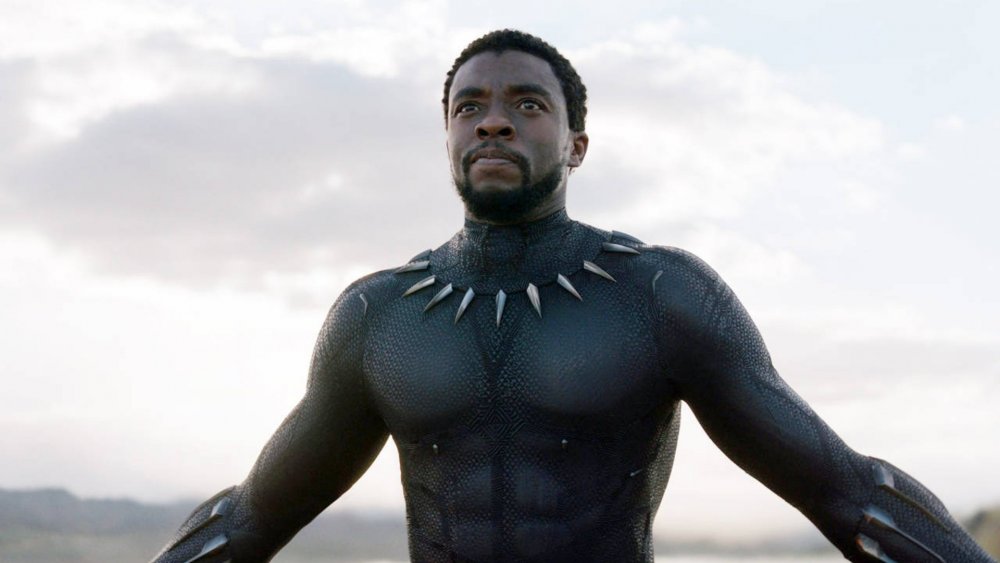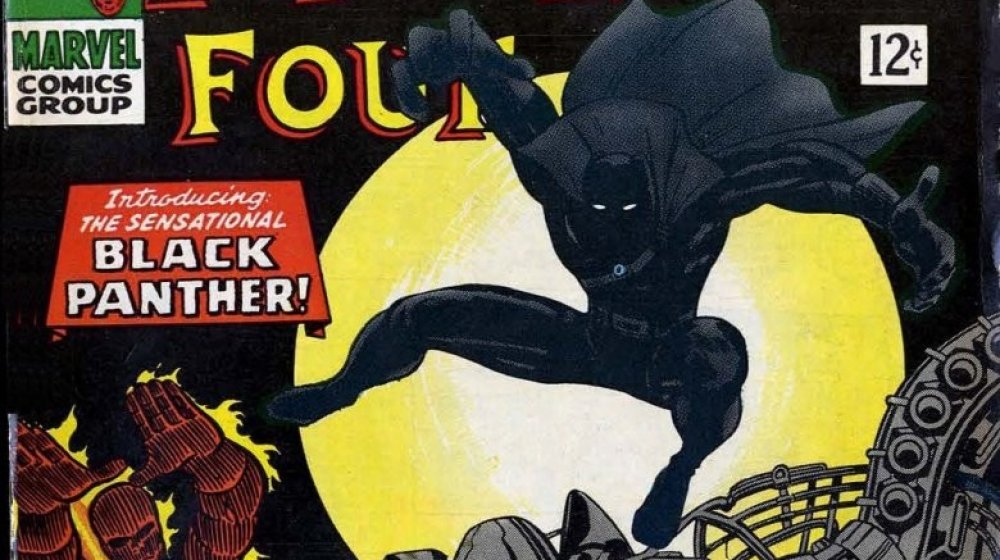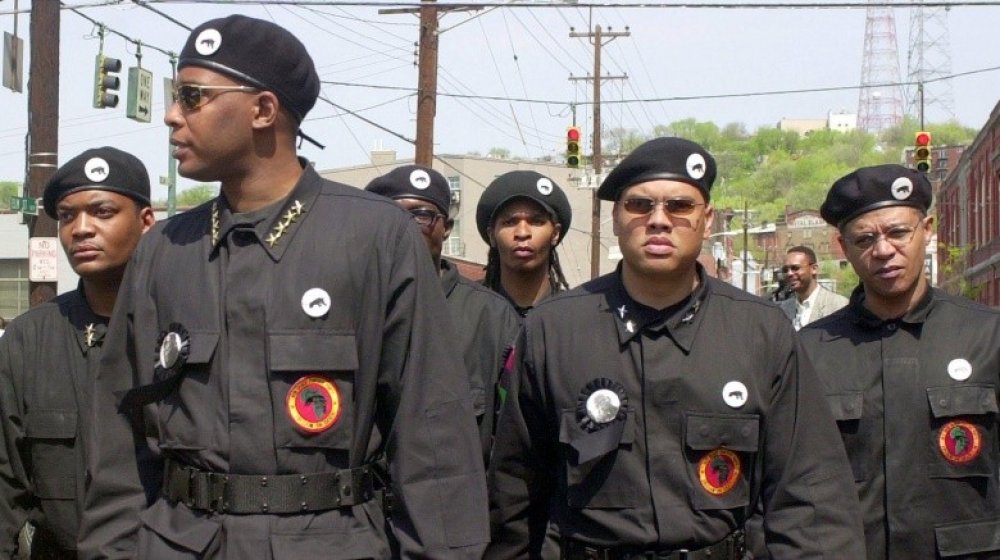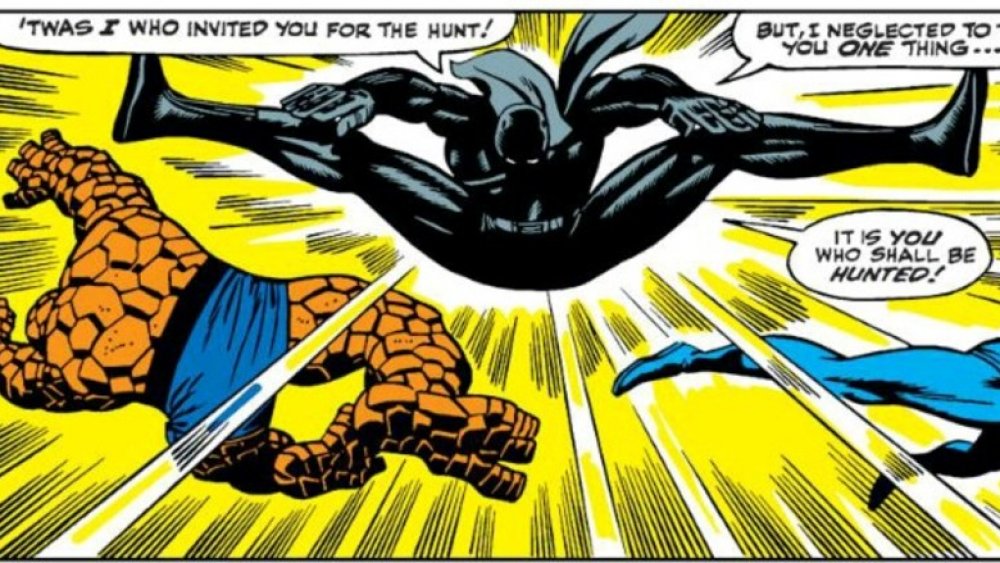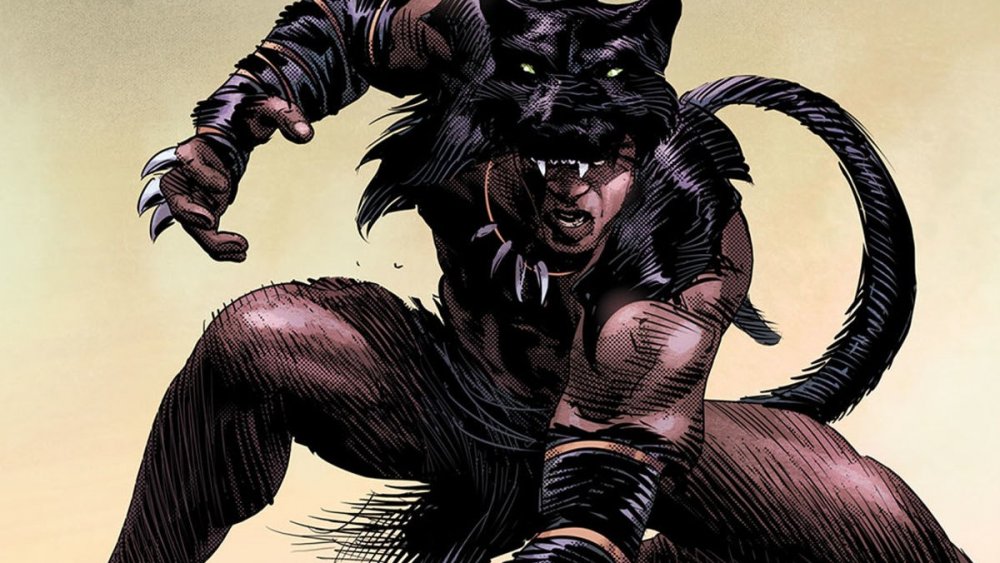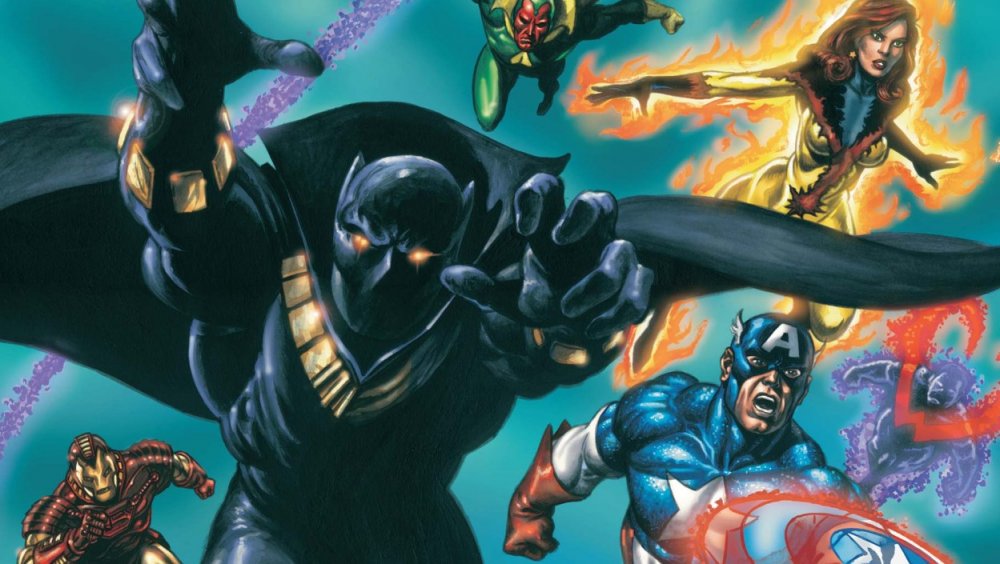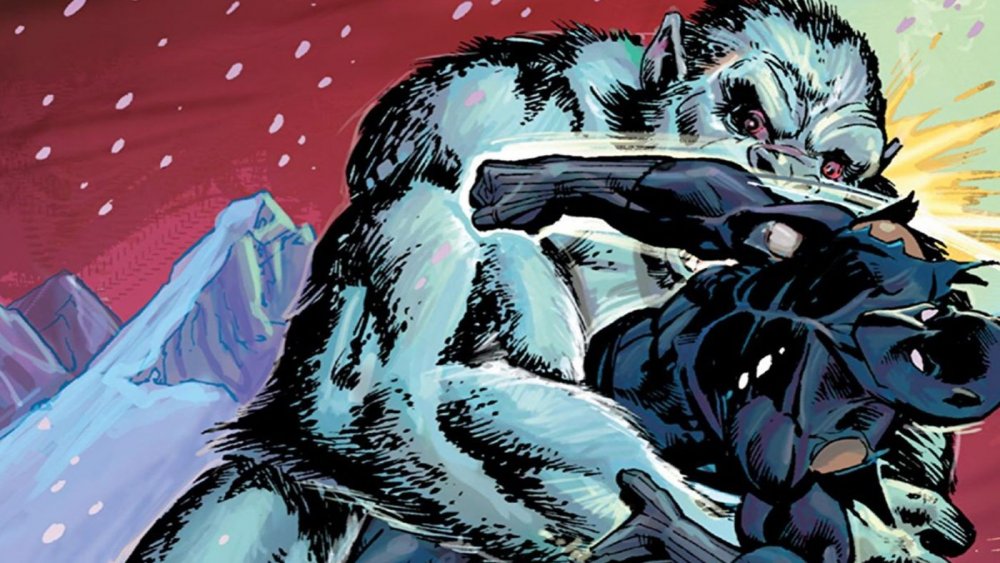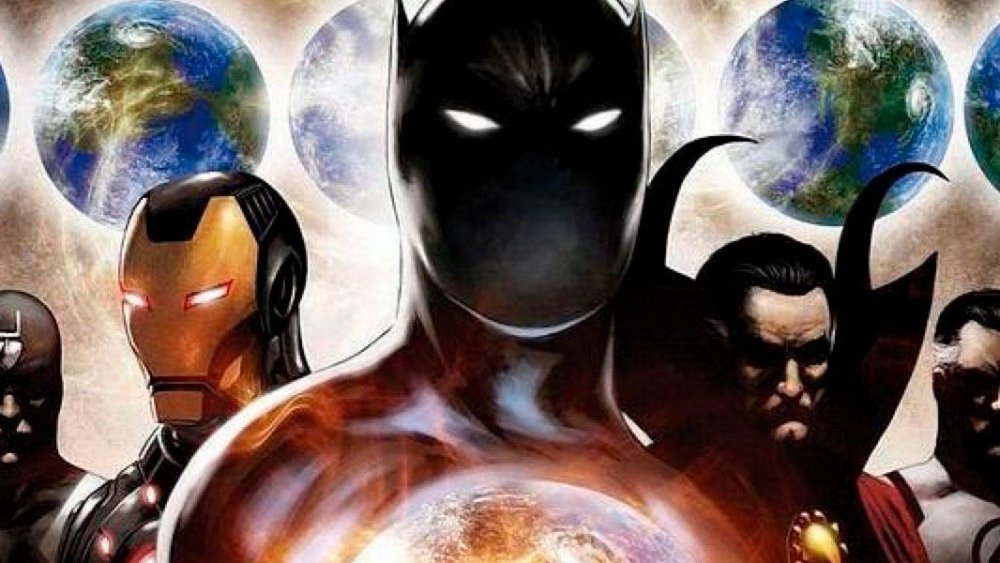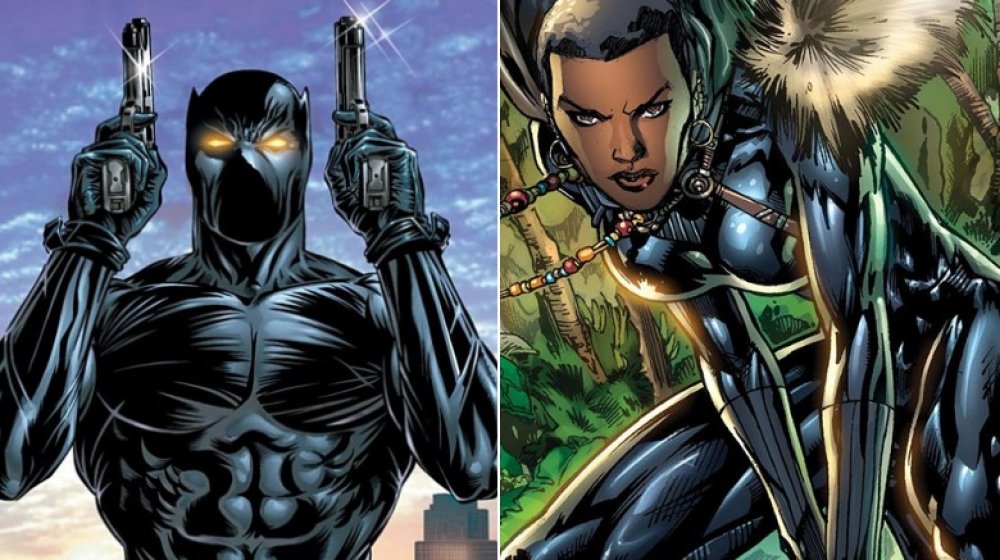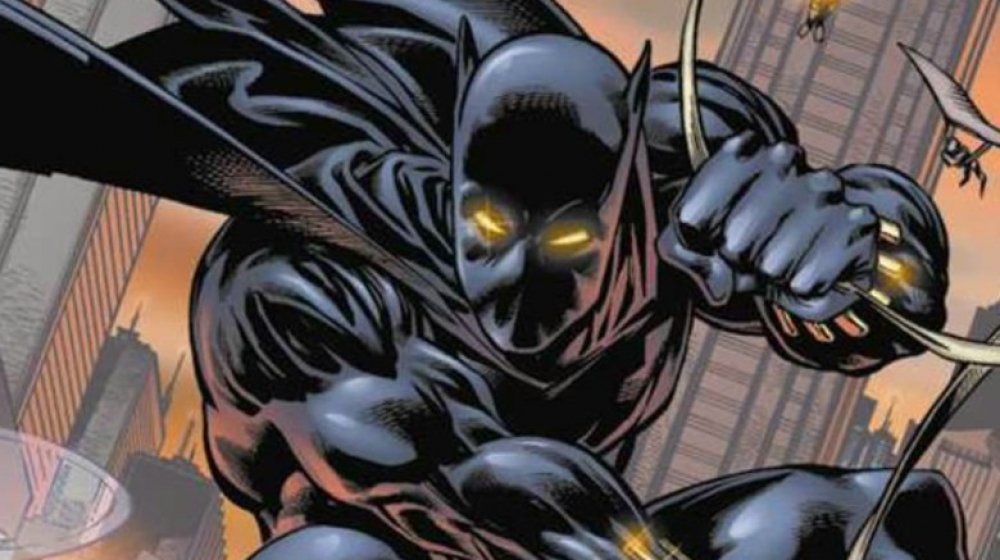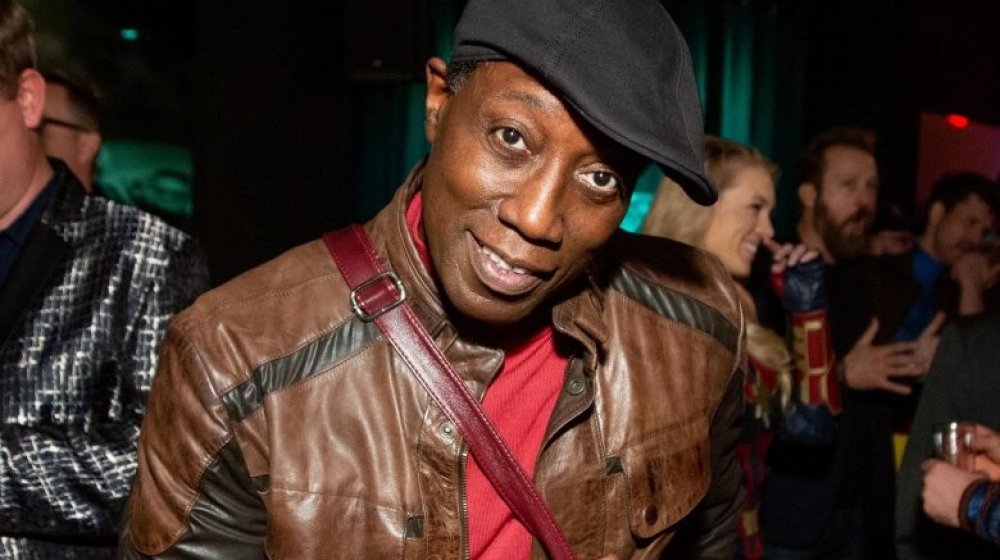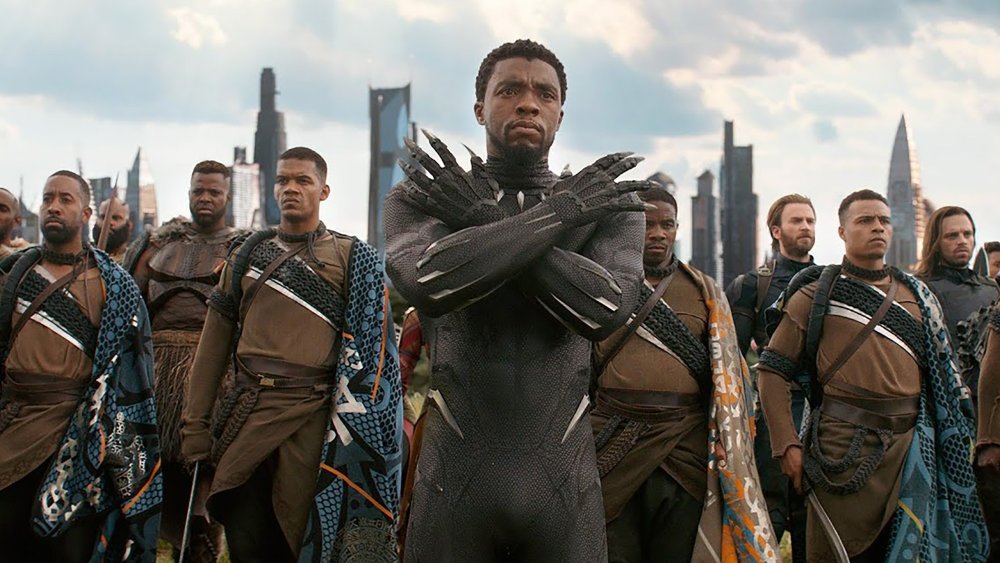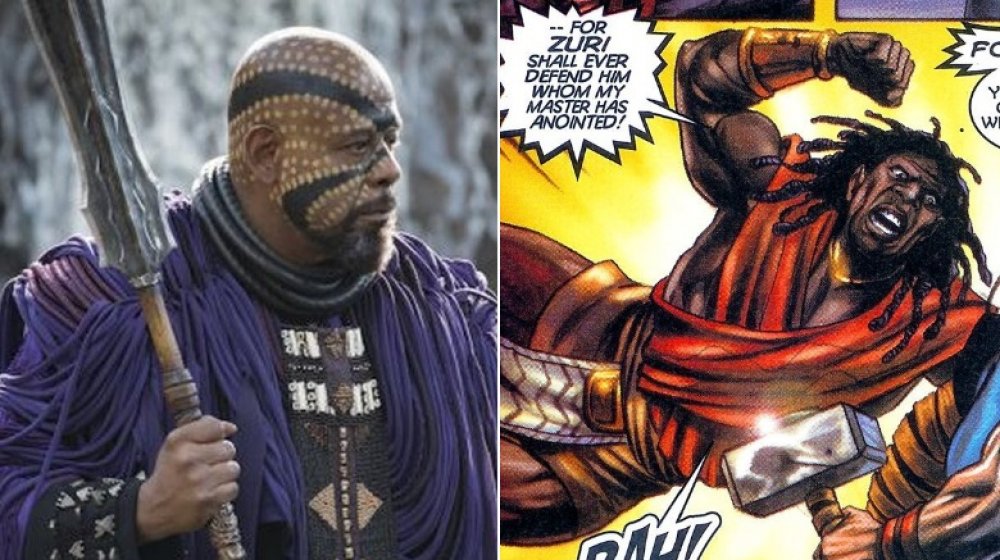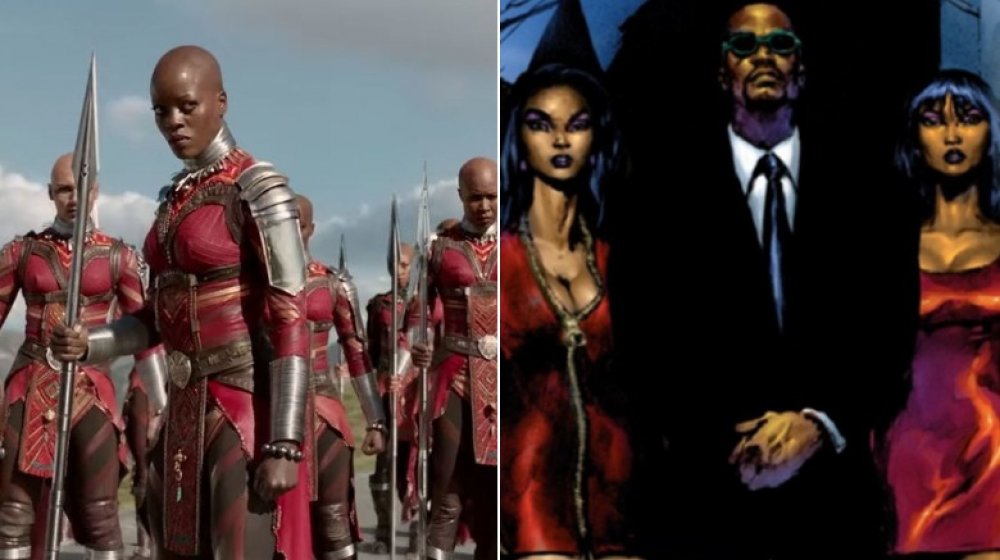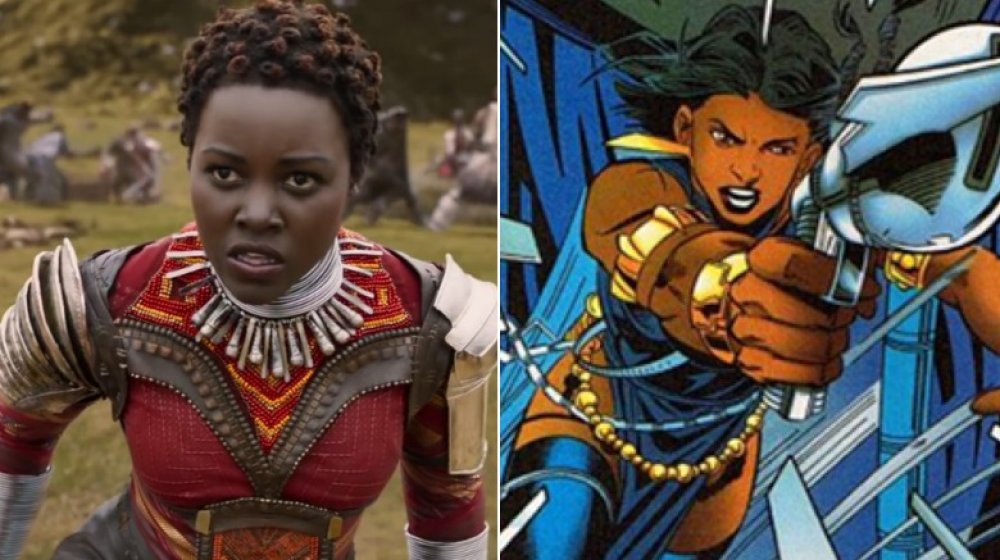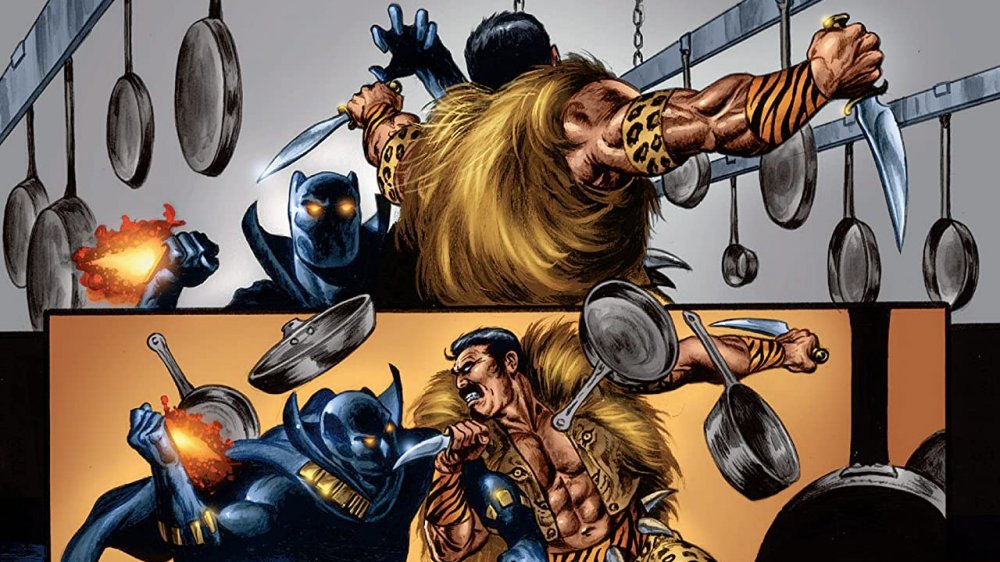The Untold Truth Of Black Panther
It may be difficult to imagine, but for many years Marvel's Black Panther struggled to support so much as a solo title. The character's subsequent success is the result of no one thing or person. From the writers and artists who conceived the king of the fictional nation of Wakanda in 1966, to those who continued his story under constant threat of cancellation, to the cast and crew who made the 2018 Black Panther film a commercial and critical slam dunk — not to mention the first superhero film to earn an Academy Award nomination for Best Picture — more than a few creative minds have helped to raise Black Panther from one of Marvel Comics' c-list heroes to a household name and icon.
Because of the character's relative obscurity before the late Chadwick Boseman portrayed him on the big screen, there's a lot that tends to be forgotten about T'Challa and those behind his creation. There are assumptions about his conception that prove false if you look closely enough, the character heralded often forgotten comic book milestones, and the differences between the source material and his realization in the Marvel Cinematic Universe (MCU) can be surprising. Even before he showed up in the MCU, he'd left important footprints on our cultural landscape, and as a result Hollywood was interested in bringing the Wakandan monarch to the big screen long before Marvel Studios existed.
To learn more, keep reading for the untold truth of Black Panther.
Black Panther was the vision of Stan Lee and Jack Kirby
The Black Panther — co-created by Stan Lee and Jack Kirby — made his debut in 1966's Fantastic Four #52. Followers of comic book history know that Lee and Kirby had some famous disagreements, but in the case of Black Panther's creation, both writer and artist agreed the king of Wakanda was needed to fill a void that had existed for too long in comic books — the existence of a Black superhero.
In a 1990 interview with The Comics Journal, Kirby recalled realizing he wanted more diversity in the comics he made: "I came up with the Black Panther because I realized I had no Blacks in my strip," Kirby said. "I suddenly discovered that I had a lot of Black readers. My first friend was a Black! And here I was ignoring them because I was associating with everybody else."
Likewise, Lee said he conceived Black Panther with Kirby because he "wanted to make the first Black superhero." In a 2011 interview with Alter Ego (via thegeektwins.com), Lee said that while creating Black Panther, he was mindful of going against stereotypes. America was used to depictions of Africa as a backward and primitive place, so Lee and Kirby gave us the exact opposite. "[Black Panther] is one of the greatest scientists in the world and his area," Lee said. "[H]is country is more scientifically advanced than any." Lee went on describe Wakanda as looking like "a scene from a science-fiction movie of the thirtieth century!"
Marvel's Black Panther and the Black Panther Party
There have been decades of confusion over whether or not there's any relationship between Marvel's Black Panther and the controversial Black Panther Party. Some assume Stan Lee and Jack Kirby swiped the name from the organization, while others will tell you the Black Panther of the comics came first — as Brian Cronin points out in a 2008 column for CBR, neither view is completely accurate.
As Cronin writes, Huey Newton and Bobby Seale founded the Black Panther Party for Self-Defense in October 1966 in Oakland, California. By this time Black Panther's first appearance in Fantastic Four #52 had already been out for the better part of a year. However, another group had the Black Panther Party name thrust upon them a year earlier. In 1965 the Lowndes County Freedom Organization (LCFO) formed in Alabama, and they chose a black panther for their party logo. The logo caused them to be known as the Black Panther Party in Alabama political circles, and the following year Newton and Seale secured the LCFO's permission to use the Black Panther name and logo for their own organization.
So while it's possible Lee and Kirby had heard of the LCFO's nickname, it seems unlikely in 1965 that the pair were paying close attention to Alabama-specific political stories. In most likelihood, the fact that Marvel and the Black Panther Party came up with the same name on the same year is more coincidence than anything else.
In his first appearance, Black Panther gave the FF a run for their money
When Black Panther first appears in Fantastic Four #52, it isn't clear that he's on the side of the angels. He sends an emissary to New York City with the gift of a high-tech flying vehicle and an invitation to the team to come to Wakanda as the king's guests. Upon their arrival T'Challa and his subjects surprise the Fantastic Four by attacking them. Ultimately, it proves to be a test. Black Panther hopes to get the FF's help in dealing with the villain Ulysses S. Klaue — who the heroes face in the following issue — but first wants to make sure they're all that they're advertised.
Eventually, the FF work as a team and overcome Black Panther, but individually T'Challa is more than a match for any single member of the team. He traps the Human Torch and sniffs out the invisible Susan Storm. Even when squaring off against the powerhouse Thing, Black Panther is able to hold his own with nothing but his fists and his wit.
In spite of their clash upon meeting, the Fantastic Four and Black Panther have long maintained close ties. T'Challa even took over as leader of the team after the events of the line-wide event Civil War. In later years, after certain revelations about Black Panther came to light, his introduction to Marvel's first family would have an ominous ring to it.
The legacy of Black Panther reaches back to prehistory
It's no secret that T'Challa isn't the first Black Panther. His father T'Chaka held the title before his son, and plenty of ancestors before T'Chaka took the responsibility on their shoulders. What you may not know is that the very first Black Panther existed deep in Marvel's past and — like T'Challa — fought alongside gods and monsters.
As part of Marvel's 2017-'18 Legacy event, it's revealed in Marvel Legacy #1 that Earth's first team of Avengers existed as far back as 1,000,000 B.C. Thor's father Odin leads the team wielding his son's future weapon Mjolnir, and the roster includes prehistoric versions of Phoenix, Iron Fist, Ghost Rider, and Starbrand. Agomotto is there as a Sorcerer Supreme long before Doctor Strange would take the title, and the first Black Panther is there as well.
Unlike T'Challa's high-tech attire, the first Black Panther wears the furs and claws of actual panthers. In 2018's Avengers #4, Odin tells Thor and She-Hulk of the prehistoric Avengers that this Black Panther was the first to discover the meteor from which Wakanda harvests its vibranium. But other than that we don't know much about him; not even his given name has been revealed, or whether he gets his abilities from the same heart-shaped herb future Black Panthers ingest. He's rarely been shown in action, though his dialogue reveals him to be as intelligent and contemplative as T'Challa, and for obvious reasons he doesn't own as many futuristic gadgets.
Black Panther didn't join the Avengers just to be a do-gooder
In 1999's Black Panther #8, the king of Wakanda drops a truth bomb that was one of the more controversial reveals in the Marvel Comics of the time. While T'Challa and his Avengers colleagues try to quell a riot masterminded by Achebe — a bad guy looking to take T'Challa's throne — Black Panther's teammates overhear him saying he initially joined the Avengers because he wanted to see if they were a threat to Wakanda.
Once the smoke clears and his teammates ask him about it, T'Challa confirms he initially joined the team to spy on them. The revelation drives a wedge between Black Panther and the rest of the Avengers, and it's particularly harmful to the friendship between T'Challa and Steve Rogers. While Black Panther would go on to be a part of future Avengers rosters, including as leader, things have never been quite the same between him and his comrades.
In 2018, writer Christopher Priest addressed fan anger over the revelation. He pointed out to ComicBook.com that, as the monarch of a sovereign nation, going off to have adventures with superheroes seemed strange for T'Challa. "I couldn't figure out why he joined the Avengers," Priest said, "and the only thing that made any logical sense to me was [Black Panther did it] to find out whether these people were a threat. Once he was comfortable they weren't a threat, he felt OK helping them out from time to time. But his number one responsibility was Wakanda."
Black Panther is the hero of Marvel's first graphic novel
The term "graphic novel" has become popularized in recent years, with some people simply using it because it sounds a lot fancier than "comic book." But a true graphic novel isn't just any comic book, but a longform and complete story with a beginning, middle, and end. In the '70s, most superhero comics would give you one- or two-part stories, but writer Don McGregor, along with artists Rich Buckler, Billy Graham and more, snuck past the editors what some call Marvel's very first graphic novel — and Black Panther was its hero.
Black Panther's first solo series was Jungle Action — a title revived from Marvel's early days as Atlas Comics. "Panther's Rage" begins with 1973's Jungle Action #6 and concludes with 1975's Jungle Action #18. The story introduces Erik Killmonger — the same character Michael B. Jordan plays to perfection in 2018's Black Panther — his plot to replace T'Challa on the throne of Wakanda, and Black Panther's long and difficult road to defeat his challenger. Along the way he fights dinosaurs, white-furred gorillas, and the snake-wrangling villain Venomm, among others.
For a superhero comic to include a 13-part story spanning two years of publication was unheard of in the mid '70s, and doesn't really happen all that often now. It seems likely Fanboy Planet is right in saying it was Marvel's "benign neglect" toward lower-selling titles that allowed for such creative freedom.
Black Panther was a part of Marvel's Illuminati
The lead up to Marvel Comics' 2006 line-wide event Civil War brought to light the existence of the Illuminati — a secret collection of heroes making decisions behind the scenes. In New Avengers Illuminati Special #1 we learn Wakanda was the host of the group's first meeting, taking place shortly after the events of the 1971-72 Kree/Skrull War storyline. Of the gathered heroes, Black Panther is the only attendee to refuse to join. He not only declines membership, he warns the heroes that what they're doing will justify any mistrust the public has toward superheroes.
But Black Panther's opposition to the Illuminati doesn't stand the test of time. In the New Avengers volume launched in 2013, after a series of so-called "incursions" begin in which Earth is threatened with destruction by colliding into alternate Earths, Black Panther helps to bring the Illuminati together once more. It speaks volumes to what T'Challa is willing to endure, considering his membership includes Namor, who — in the previous year's Avengers Vs. X-Men event — murdered untold numbers of Wakandans. The Illuminati eventually resorts to saving the prime Marvel timeline by destroying others, though ultimately the incursions continue until the Marvel Universe is destroyed and remade with the 2015 miniseries and event Secret Wars.
Black Panther's involvement with the Illuminati presumably ends with Secret Wars, but you never can tell. The group seems to keep finding its way back no matter what.
T'Challa isn't the only Black Panther
T'Challa is part of a long line of warrior kings who have assumed the title of Black Panther. What's not quite as well known are the characters who have taken the name Black Panther while T'Challa was — more or less — still alive. For example, Erik Killmonger defeats T'Challa in one-on-one combat in 2000's Black Panther #20, earning him the right to become the king of Wakanda as well as the next Black Panther. His reign ends in Black Panther #24, however, when he eats the heart-shaped herb which gives the Black Panthers their powers and — because he is not of the royal bloodline — falls into a coma.
In 2002's Black Panther #50, after the rumored death of T'Challa, a mysterious new Black Panther appears in New York City wearing an overcoat over his vibranium-laced outfit and two-fisting pistols loaded with non-lethal rounds. This new Panther proves to be NYPD officer Kasper Cole, who swipes the uniform and uses it bring his corrupt superior officer to justice. After T'Challa reappears, Cole takes the name White Tiger and continues to fight crime.
It's T'Challa's own sister Shuri who becomes Queen of Wakanda when T'Challa falls into a coma due to the machinations of Doctor Doom in the volume of Black Panther launched in 2009. T'Challa emerges from his coma eventually, but Shuri remains Black Panther until she sacrifices herself to save her brother when the villainous Cabal tears through Wakanda in 2014's New Avengers #24.
The Black Panther of Christopher Priest
Until the success of 2018's Black Panther made more people aware of his work, writer Christopher Priest was a largely unsung hero in the history of Black Panther. In spite of its relatively low sales, Priest's 1998-2003 run of Black Panther redefined the character. Without it, there would be no Black Panther film or — at the very least — it would've been a much different movie, and probably nowhere near as successful. As Ta-Nehisi Coates, another Black Panther writer, told Vulture, "He had the classic run on Black Panther, period, and that's gonna be true for a long time. People had not put as much thought into who and what Black Panther was before Christopher started writing the book."
In 2018, Priest told ComicBook.com he was initially hesitant to write Black Panther, but changed his mind when he was told he could reinvent the character as he saw fit. One of Priest's guiding stars was thinking of T'Challa not as a superhero, but as a king. Told through the eyes of T'Challa's hapless sidekick Everett K. Ross, Priest's Black Panther is a colder and more aloof version of the character who places his role as king before anything — including his duties as an Avenger. "He's not allowed to think much about himself or do much for himself," Priest told ComicBook.com. "His main responsibility is Wakanda... he's not really a superhero. This guy is a monarch; he's following his own agenda."
Wesley Snipes tried to get a Black Panther film made in the nineties
While Marvel Studios' Black Panther was the first film to feature T'Challa as its lead character, it wasn't the first attempt to make such a film. In early 2018, Wesley Snipes talked to The Hollywood Reporter about his own attempt to bring the king of Wakanda to the big screen in the '90s.
Marvel approached Snipes with the idea of a Black Panther film, and it wasn't a hard sell. A big part of what hooked Snipes to the project was the idea of Africa being depicted differently from Hollywood's usual portrayal of a "depressing, desolate land." Snipes told THR "Many people don't know that there were fantastic, glorious periods of African empires and African royalty." In spite of what Snipes recalled with laughter as an ill-conceived pitch by late writer/director John Singleton, the project initially looked promising. Then Marvel Editor-in-Chief Tom Defalco remembered being impressed at a pitch meeting with the attached screenwriter Terry Hayes, in spite of yawning through years of other Marvel movie pitches.
Sadly, this early Black Panther project was plagued with problems. Snipes said the first major issue was convincing film executives they weren't making a movie about the Black Panther Party. He added that after several script rewrites the project "couldn't find the right combination of script and director." Rather than Black Panther, Snipes would go on to make the first successful live-action film based on a Marvel hero — 1998's Blade.
Chadwick Boseman saw Black Panther as an anti-superhero
Black Panther proved to be one of the most critically and commercially successful superhero films Hollywood has ever made. Ironically, according to the late Chadwick Boseman, who played King T'Challa in four MCU films beginning with 2016's Captain America: Civil War, in many ways Black Panther is more like The Godfather's Michael Corleone than he is like Iron Man or Captain America.
Speaking to ComicBook.com in late 2017, Boseman called Black Panther an anti-hero. "At times [Black Panther] feels like The Godfather," Boseman said. "It's complicated when you have to deal with who should live and who should die. Sometimes you have to do bad things or you maybe need to do bad things so there's justice, so there's peace." Fittingly, Boseman's interpretation of the character echoes the writing of Christopher Priest, who saw Black Panther as a monarch responsible to his people's well-being rather than a superhero reacting to crises.
Adding more irony to Boseman's take on T'Challa, he also echoed Spider-Man's classic mantra about great power bringing great responsibility. "[Black Panther] is about how you use power," Boseman said. "What do you do when you get power? In this case, you're talking about someone taking the throne. But all superhero movies are about a person who has extreme power... The only difference between a hero and the villain is that the villain chooses to use that power in a way that is selfish and hurts other people."
In the comics, Zuri is a lot less cerebral
Forest Whitaker plays Zuri in Black Panther – an adviser to T'Challa as well as a trusted friend of his father, T'Chaka. Killmonger murders the elder after Zuri admits to betraying the usurper's father. Zuri, like many of the characters in the film, comes from the source material, but he's a very different guy on the screen.
Zuri first appears in the comics in 1998's Black Panther #1. Like his movie counterpart, the comic book Zuri is loyal to T'Challa and faithfully served T'Chaka before him. Unlike Forest Whitaker's Zuri, who is usually a calm and rational voice of reason to his king, the Zuri of Marvel's comics is a loud, abrasive warrior ready to start a fight at the slightest provocation. While in no way portrayed as being unintelligent, Zuri simply seems to prefer violence to other solutions, and is far from the levelheaded adviser seen in the film. Zuri's constant outbursts lead him to being a usual source of humor in the comics. For example, in 2002's Black Panther #44, after T'Challa stages a hostile takeover of Stark Enterprises and places Zuri in charge of answering his phones, the warrior yells at a caller, "Do not make me crush you like the insect that you are! May I take a message?"
The Zuri of the comics unfortunately is like the movie version in that he dies serving Wakanda. The warrior is killed by the villain Morlun in 2009's Black Panther #5.
In the comics, the Dora Milaje had a different origin
One of the more popular aspects of 2018's Black Panther is the introduction of the Dora Milaje — elite warriors, all women, dedicated to protecting whoever sits on the throne and serving Wakanda. In the film, the Dora Milaje are led by General Okoye (Danai Gurira), who would go on to have a prominent role in Avengers: Infinity War. The Dora Milaje are lifted from the comics — specifically from Christopher Priest's 1998-2003 run on Black Panther — but a significant piece of their story was left out of the film.
Like the Dora Milaje of the movie, their comic book counterparts are highly skilled warriors, but they are also T'Challa's "wives in waiting." None of the Dora Milaje are actually married to T'Challa, but they are not allowed to become romantically involved with anyone else. Each member of the Dora Milaje is sent to T'Challa from a different Wakandan tribe, and their presence helps keep peace in the nation. According to tradition, the king may choose one of the Dora Milaje to be his wife, but doing so could create unrest among Wakanda's different factions.
The existence of the Dora Milaje creates a number of complications for T'Challa during Priest's run, including the resistance of the rebellious Queen Divine Justice — a Chicago-raised woman who is a descendant of Wakanda's Jabari tribe and recruited into the Dora Milaje, but wants nothing to do with the group and briefly counts the Incredible Hulk as her boyfriend.
Nakia is a villain in the comics
In Black Panther, Lupita Nyong'o plays Nakia, T'Challa's former lover and a loyal spy for Wakanda. In spite of no longer being romantically attached to Black Panther, Nakia is fiercely loyal to T'Challa, his family, and the throne. Like Okoye and Shuri (played by Letitia Wright), Nakia is one of the allies instrumental in defeating Killmonger and restoring T'Challa to the throne. She's also arguably Black Panther's most blatant departure from the source material.
Introduced during Christopher Priest's Black Panther run, Nakia is one of T'Challa's Dora Milaje. Like the other women counted among the king's protectors, she's a formidable warrior willing to do anything her monarch asks. But in 1999's Black Panther #3, a seed is planted that puts Nakia on a darker path. The devilish Mephisto creates an illusion, making T'Challa believe he's kissing his former lover Monica Lynne, when he's really kissing Nakia in the back of his limousine. This adds fuel to an already powerful infatuation Nakia has for T'Challa. Her fellow Dora Milaje urge her not to dwell on the kiss, but she's already convinced T'Challa is in love with her. Her obsession leads her to eventually abandon her duties as Dora Milaje and become the villain Malice.
As part of Marvel's 2018 Wakanda Forever event, Nakia redeems herself before her death. In Wakanda Forever: Avengers #1, she dies fighting alongside the Dora Milaje and is buried with honor among her fallen sisters.
Ryan Coogler wanted a Spider-Man villain for Black Panther
The Black Panther film managed to work in a number of the hero's signature comic book bad guys. Along with Killmonger, we meet Ulysses Klaue (Andy Serkis) and M'Baku (Winston Duke) who is known as the villain Man-Ape in the comics. But while speaking to Yahoo! Movies in 2018, director Ryan Coogler admitted there was at least one bad guy he wanted to use but couldn't — Kraven the Hunter.
Coogler called Christopher Priest's time on Black Panther a "heavy run," and singled out a fight that takes place between Black Panther and the Russian villain Kraven as inspiring him to go to Marvel about using the jungle-themed mercenary. "I've always loved Kraven the Hunter in almost every iteration," Coogler said. "So there was a moment — 'Can I grab Kraven?' — and they were 'Nah, you don't have Kraven.'" As he's a villain most closely associated with Spider-Man, Sony owns the film rights to Kraven, and the Hunter isn't part of the deal that allows Marvel Studios to use the web-slinger in their films.
In most likelihood, the fight scene Coogler references from Priest's run is the impressively rendered battle between the pair in the kitchen of the New York Hilton in 1999's Black Panther #6. Drawn by Joe Jusko, the six-page fight sequence is an intense battle done almost completely without dialogue, save for some manic laughter that erupts from Kraven after T'Challa dislocates his shoulder.
